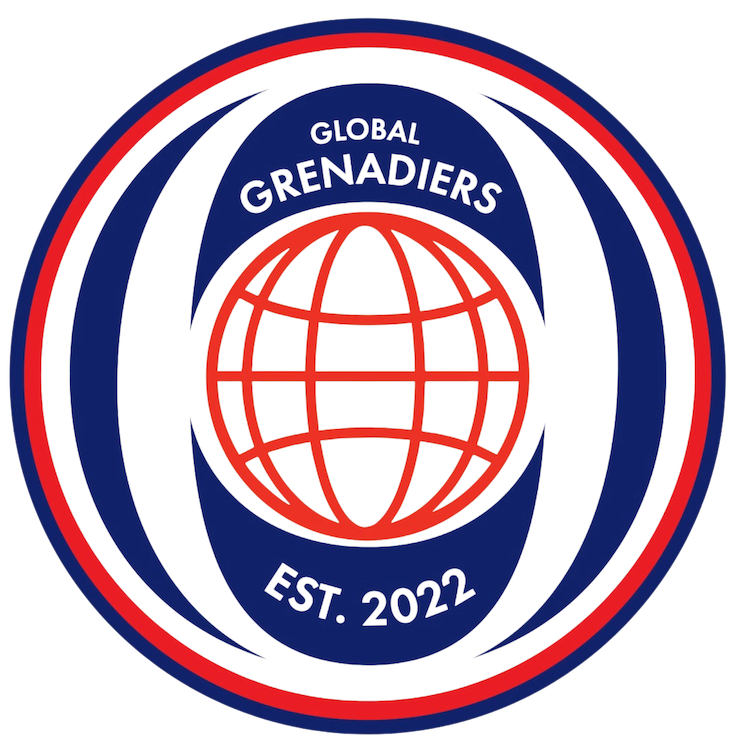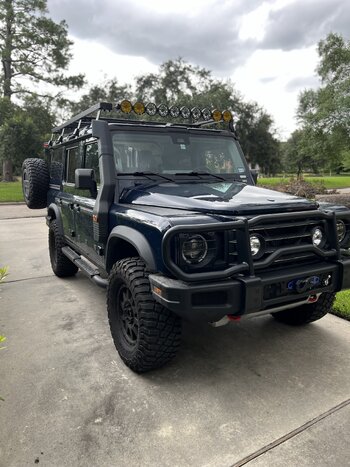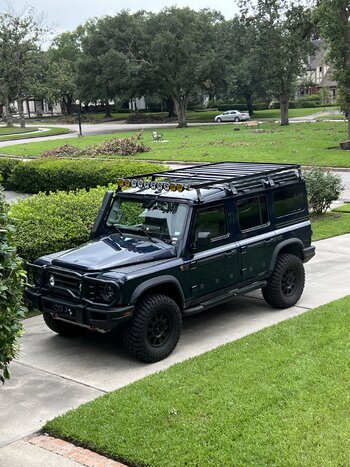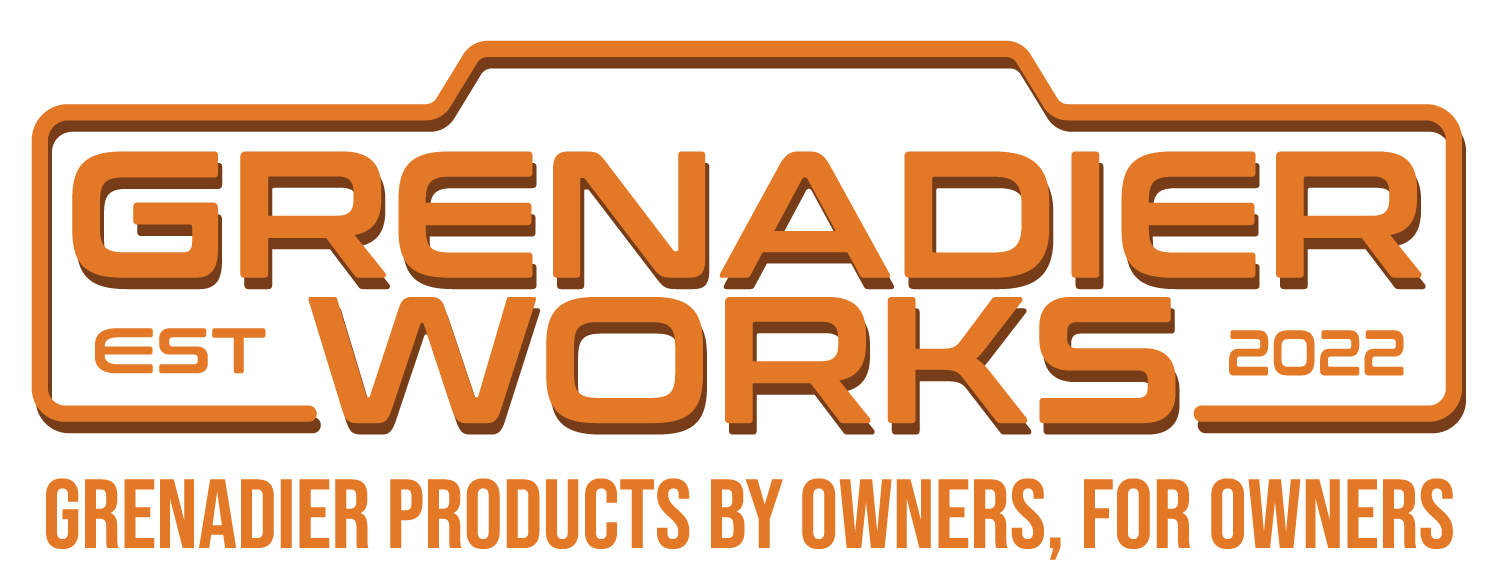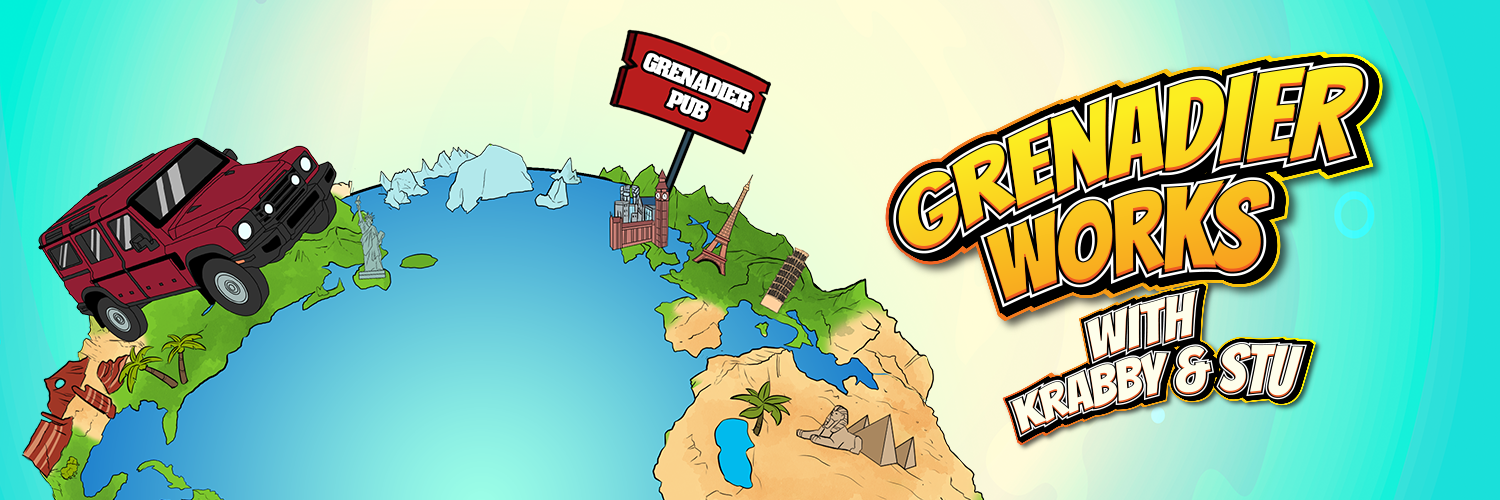2.5” prototype lift with prototype piggyback shocks and 500lb rear HD springs. Running 35x12.5 on 17x8 wheels. Will be putting in double cardan driveshafts shortly.
The Grenadier Forum
Register a free account today to become a member! Once signed in, you'll be able to contribute to the community by adding your own topics, posts, and connect with other members through your own private inbox! INEOS Agents, Dealers or Commercial vendors please contact admin@theineosforum.com for a commercial account.
You are using an out of date browser. It may not display this or other websites correctly.
You should upgrade or use an alternative browser.
You should upgrade or use an alternative browser.
Eibach 2.5 Lift Kit w/ 34x10.5x17” BFG KO2 Installed!
- Thread starter bikesandguitars
- Start date
Is your car green?I haven’t had it aligned yet the Big O tire didn’t have the specs in there hunter system. The Grenadier dealer is doing a free alignment Monday since I had a toe hang issue they day I got it my wheel was sitting at 10 o’clock when driving straight vs. 12 o’clock hope that helps? If not I might remove the 2.5 spring and try the 1.7 lower the front end..my front end is sitting up so high I have wind noise issues at speeds over 70 that were not there before…..plus its my wife’s car! Thanks for reply.
Why do this? Not being smart - I'm just a novice off-roader and not sure I know what this is or why it's important? Your Gren is looking amazing.Will be putting in double cardan driveshafts shortly.
When you raise the car, what you really raise is the chassis and body, but you do not raise the axles, therefore the engine is placed higher and the axles stay in the same place, so the cardan shafts completely change their geometry, remaining in a much greater coupling inclination, to avoid this, double-knot cardans are used that make it easier for the coupling angle to be the same as the factory one, avoiding breakage problems during insertion.Why do this? Not being smart - I'm just a novice off-roader and not sure I know what this is or why it's important? Your Gren is looking amazing.
Greetings
Paco Garcia
Ahh - Makes much sense now - thank you for the great explanation! I'm considering the 2.5" eibach lift springs, and want to make sure I'm not overlooking something that I should consider (as part of the install of this) to ensure everything is proper. Sounds like the double cardans are probably a good risk mitigating piece of kit if you run the 2.5" lift springs.When you raise the car, what you really raise is the chassis and body, but you do not raise the axles, therefore the engine is placed higher and the axles stay in the same place, so the cardan shafts completely change their geometry, remaining in a much greater coupling inclination, to avoid this, double-knot cardans are used that make it easier for the coupling angle to be the same as the factory one, avoiding breakage problems during insertion.
Greetings
Paco Garcia
Is a double cardan driveshaft available?Will be putting in double cardan driveshafts shortly.
Mine is the same on highway... any speed over 65 is terrifying. 35x12.50 BFG M/T aired down and it still doesn't feel great/safe on the highway. I'm going to try Eibach shocks/stabilizer when they become available and I'll also have the caster checked out.Im curious on how the ride is better? I did the Eibach 2.5 Front & 1.7 rear - did the Fox Steering stabilizer - 287/75r17 AT3 on 17” steel wheels and hate the ride - its horrible - I was on our toll road doing 70 holding a bend in the road and the car was literally bouncing as I held the line - I have 200 miles on the springs and very disappointed - it looks freaked amazing but - might return it too stock I just hope I can run the same tires if not it was a 5000 experiment..
I have an appointment set for Tuesday with Owl Vans to install a set of 30mm Eibach springs and 285/75/R17 KO2s on the stock steel wheels.Mine is the same on highway... any speed over 65 is terrifying. 35x12.50 BFG M/T aired down and it still doesn't feel great/safe on the highway. I'm going to try Eibach shocks/stabilizer when they become available and I'll also have the caster checked out.
Should I proceed or postpone? Should I consider adding an aftermarket stabilizer?
I have an appointment set for Tuesday with Owl Vans to install a set of 30mm Eibach springs and 285/75/R17 KO2s on the stock steel wheels.
Should I proceed or postpone? Should I consider adding an aftermarket stabilizer?
First, AWESOME member name 74CampySuperRecord!!I have an appointment set for Tuesday with Owl Vans to install a set of 30mm Eibach springs and 285/75/R17 KO2s on the stock steel wheels.
Should I proceed or postpone? Should I consider adding an aftermarket stabilizer?
Our local dealer just installed the 30mm Eibach springs and BFG KO2 285/75/R17's on my rig. I also have the Fox stabilizer and stock steel wheels. I had concerns regarding anything above the 30mm height eventually causing front drive line issues offroad. Be sure to have your installer increase the caster adjustment when they realign your rig. The folks at Owl know their stuff. My rig drives better than stock and I think the combination of bigger/wider rubber, increased caster, and an overall better alignment contribute to that. I have less wandering than I did with the stock set up. Post a pic after you get it done!
Today nearly 400km Autobahn, most 120-130, but also 150-160km/h. German autobahn, just one finger at the steering wheel!Mine is the same on highway... any speed over 65 is terrifying. 35x12.50 BFG M/T aired down and it still doesn't feel great/safe on the highway. I'm going to try Eibach shocks/stabilizer when they become available and I'll also have the caster checked out.
I too am NOT having any issues. I also Have the 2.5 lift on 35’s but stayed with the stock stabilizer and honestly like the ride and handling. Recently drove to Idaho from Texas and performed perfectly even at high speeds. However, the lights on the roof rack are pretty loud at high speeds. Thinking about going with a lower profile rack.I’m not having any issues. I didn’t use the Fox stabilizer as I had no complaints on the steering when it was stock. It’s hard to quantify what I like about the ride but I do notice the front end being more level and the increased overall higher ride height. It also seems to ride quieter. I would also say that the lift kit springs offer better small bump compliance. Again, I had no complaints when it was stock.
The big variable here could be the alignment spec. The shop I used had a lot of advance warning that I was bringing it in for a lift. They were not familiar with the Grenadier. I sent them a few YouTube videos a few weeks before our appointment. They reached out to Ineos to verify the alignment numbers.
The other variable is just preference. We like what we like. If you’re sure everything is set up correctly, then it probably was a costly experiment. The good news is that I’m sure you can likely recoup most of your spend.
Attachments
What rack/light setup are you running?I too am NOT having any issues. I also Have the 2.5 lift on 35’s but stayed with the stock stabilizer and honestly like the ride and handling. Recently drove to Idaho from Texas and performed perfectly even at high speeds. However, the lights on the roof rack are pretty loud at high speeds. Thinking about going with a lower profile rack.
Front runner rack and Colight lights…What rack/light setup are you running?
My car was at a driveline shop yesterday for R&D. They’re building adapters that should be available within 2-3 weeks. Then I’ll be putting in extended brake lines or at least relocating them.Is a double cardan driveshaft available?
Car was at the driveline shop yesterday for R&D. Hopefully we will have a shaft within 2-3 weeks, adapters are being made for the diff and transfer case.Your gren is looking sweet as usual, I look forward to reading about the drive shafts!
Just as paco said. To elaborate, many factory vehicles come with a CV driveshaft that is comprised of bearings, a boot, and grease. This is ok for small tires, low torque, and mild offroad applications. CV’s are also good as axle shafts if beefed up such as RCV’s since the torque transfer works in a different way. As a driveshaft it is a suboptimal component as it is prone to breakage from torque transfer, extreme articulation, or boot failure. All of this is greatly enhanced when lifted as the CV can only handle so much angle before the boot gets pinched and the torque load is placed upon the bearings at a suboptimal angle. What then happens is either the bearings get prematurely worn or dislodged from their races, or the boot gets pinched, dirt gets in, and then grease spews everywhere, the balls fly out, and then the shaft flails everywhere causing potential secondary damage. This is a hard down on the trail either requiring a tow off the trail or pulling the shaft leaving you without 4 wheel drive, unless you carry a spare.Why do this? Not being smart - I'm just a novice off-roader and not sure I know what this is or why it's important? Your Gren is looking amazing.
A double cardan replaced this weak design with several key improvements. First, the actual shaft is made from a much stronger and thicker shaft, reducing the threat of twisting or shearing the shaft. Second, a beefy slip yoke is installed to allow for longer travel without risk of over extending or compressing the shaft thus bottoming or dropping the shaft. Third, the CV is replaced with a double cardan or double u joint set up, which is much more robust and also rebuildable. This allows for the shaft to operate under high torque loads at extreme angles without the threat of pinching a boot or operating beyond a CV’s angle capacity.
This is a common theme in the Jeep, rock crawling, and Baja racing community. I’ve seen dozens of shaft failures on the trail, effectively shutting our run down so that we could either repair a rig or at least get it off of the trail. I lost a factory rear driveshaft on the rubicon trail as it was pretzeled off since it couldn’t handle the torque and grip being applied to the 38” tires at the time. Several members of our rock crawling club have grenaded front CV’s on trips simply because they didn’t want to change it out yet. If you plan on staying stock height with a maximum 33” tire, I think the stock shaft is ok, anything beyond that it’s a ticking time bomb.
Thanks so much @Bodhi’s Grenadier for taking the time to provide this great information - this is all new to me since getting the grenadier, so the detail and logic behind some of the decisions is super helpful to read! As Paco mentions too - this all makes perfect sense to me, and if I do decide to go with a lift, I’ll likely want to also budget for double cardans as well (and whenever they are available) .Just as paco said. To elaborate, many factory vehicles come with a CV driveshaft that is comprised of bearings, a boot, and grease. This is ok for small tires, low torque, and mild offroad applications. CV’s are also good as axle shafts if beefed up such as RCV’s since the torque transfer works in a different way. As a driveshaft it is a suboptimal component as it is prone to breakage from torque transfer, extreme articulation, or boot failure. All of this is greatly enhanced when lifted as the CV can only handle so much angle before the boot gets pinched and the torque load is placed upon the bearings at a suboptimal angle. What then happens is either the bearings get prematurely worn or dislodged from their races, or the boot gets pinched, dirt gets in, and then grease spews everywhere, the balls fly out, and then the shaft flails everywhere causing potential secondary damage. This is a hard down on the trail either requiring a tow off the trail or pulling the shaft leaving you without 4 wheel drive, unless you carry a spare.
A double cardan replaced this weak design with several key improvements. First, the actual shaft is made from a much stronger and thicker shaft, reducing the threat of twisting or shearing the shaft. Second, a beefy slip yoke is installed to allow for longer travel without risk of over extending or compressing the shaft thus bottoming or dropping the shaft. Third, the CV is replaced with a double cardan or double u joint set up, which is much more robust and also rebuildable. This allows for the shaft to operate under high torque loads at extreme angles without the threat of pinching a boot or operating beyond a CV’s angle capacity.
This is a common theme in the Jeep, rock crawling, and Baja racing community. I’ve seen dozens of shaft failures on the trail, effectively shutting our run down so that we could either repair a rig or at least get it off of the trail. I lost a factory rear driveshaft on the rubicon trail as it was pretzeled off since it couldn’t handle the torque and grip being applied to the 38” tires at the time. Several members of our rock crawling club have grenaded front CV’s on trips simply because they didn’t want to change it out yet. If you plan on staying stock height with a maximum 33” tire, I think the stock shaft is ok, anything beyond that it’s a ticking time bomb.
Dumb question: Curious if this is still an issue with portal axles? Not that I ever plan to go that direction
Aired down? its bound to feel vague and wobbly with aired down 35's! You should air them up, min 35psi preferably 40+. The bigger the tyre the more vague the whole thing will feel. You have the added body roll from the lift plus the added body roll from the bigger tyres plus the added body roll from airing them down. You can't do anything about the first two but you can air them up at least, also max out the caster correction if you haven't already.Mine is the same on highway... any speed over 65 is terrifying. 35x12.50 BFG M/T aired down and it still doesn't feel great/safe on the highway. I'm going to try Eibach shocks/stabilizer when they become available and I'll also have the caster checked out.
The CV driveshaft is a weak link in the drivetrain regardless of lift, stock, or portals because of its design and strength loss during application of torque at extreme angles. Although portals will put less angled stress on the CV joint, they allow for fitment of larger tires without altering the suspension geometry by adding an additional dropped drive component at the axle ends, which still translates to greater rotational mass and traction. If someone is dropping portals in they’re likely planning on heavy offroad use so I’m certain they’ve already got a DC shaft or are planning on getting one!Thanks so much @Bodhi’s Grenadier for taking the time to provide this great information - this is all new to me since getting the grenadier, so the detail and logic behind some of the decisions is super helpful to read! As Paco mentions too - this all makes perfect sense to me, and if I do decide to go with a lift, I’ll likely want to also budget for double cardans as well (and whenever they are available) .
Dumb question: Curious if this is still an issue with portal axles? Not that I ever plan to go that direction
Very true, the taller the tire, the greater the sidewall deflection and roll, which will exacerbate the added body roll inherent with a lift. I am currently running 38 front and 42 rear. I also have the HD springs in the rear that reduced the roll substantially and the piggyback shocks helped mitigate it a bit. You can effect body roll through multiple avenues. You can change the joints to spherical instead of bushings. You can change shocks, ideally to remote reservoirs with adjustable compression and rebound. You can change the weight of the springs or their type, whether single rate or progressive, coilovers with true dual rate and helper springs would be ideal. You could get bigger wheels to reduce sidewall while maintaining size but you’ll sacrifice comfort and offroad capability for on road handling. The only free thing you can really effect is tire pressure to stiffen the tire, but you’ll sacrifice comfort and potentially cause uneven wear or flightiness.Aired down? its bound to feel vague and wobbly with aired down 35's! You should air them up, min 35psi preferably 40+. The bigger the tyre the more vague the whole thing will feel. You have the added body roll from the lift plus the added body roll from the bigger tyres plus the added body roll from airing them down. You can't do anything about the first two but you can air them up at least, also max out the caster correction if you haven't already.
I would highly advise against maxing out the caster beyond 1.5 as this will push the CV driveshaft beyond its already tight tolerance.
Similar threads
- Replies
- 13
- Views
- 364
- Replies
- 64
- Views
- 8K
- Replies
- 7
- Views
- 2K
- Replies
- 15
- Views
- 893
- Replies
- 100
- Views
- 17K
